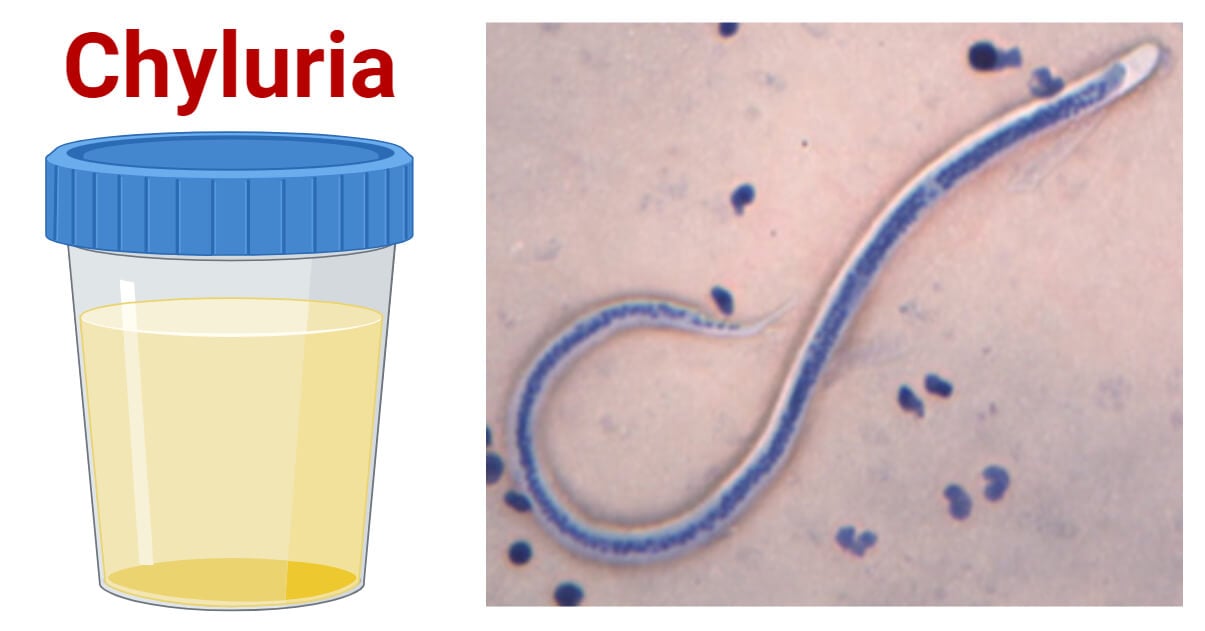Chyluria is a medical condition characterized by the abnormal presence of chyle, a milky white fluid comprising lymph and dietary fats, in the urine.
This condition occurs when the lymphatic system, responsible for transporting lymph fluid throughout the body, malfunctions.

Normally, the lymphatic vessels collect excess tissue fluid, forming lymph, which is eventually emptied into the bloodstream.
Interesting Science Videos
Historical Context and Prevalence of Chyluria
Chyluria has been recognized for centuries and is believed to have historical ties to various cultures.
Historically, the condition was often associated with parasitic infections, such as filariasis- a disease caused by parasitic worms known as filarial worms. It has been documented in regions where these parasites are endemic.
The prevalence of chyluria varies across different geographical locations, particularly in areas where filariasis is prevalent. In certain parts of Asia, Africa, and tropical regions, chyluria has been reported more frequently due to the higher incidence of filarial infections.
Over time, advancements in medical understanding and the development of diagnostic tools have improved the recognition and diagnosis of chyluria.
Etiology and Causes of Chyluria
The lymphatic system is a vital part of the circulatory system, comprising a network of lymphatic vessels, lymph nodes, and organs like the tonsils, spleen, and thymus. Its primary role is to transport lymph, a clear fluid containing white blood cells and proteins, throughout the body. The lymphatic system plays a crucial role in immune function, fat absorption from the digestive system, and fluid balance within tissues.
In the context of chyluria, the lymphatic system’s malfunction leads to the abnormal presence of chyle, a milky fluid rich in lipids, within the urinary tract.
Normally, the lymphatic vessels drain excess chyle back into the bloodstream. However, disruptions in this process, often due to injury or blockage, can cause chyle to enter the urinary system, resulting in chyluria.
Causes, Including Parasitic Infections, Malignancies, and Other Factors
Several underlying factors can cause disruptions in the lymphatic system, leading to chyluria. Parasitic infections, particularly filariasis caused by Wuchereria bancrofti, are a common cause. These parasites can obstruct lymphatic vessels, disrupting the normal flow of lymph and causing chyluria.

Malignancies, such as lymphomas or cancers affecting the lymph nodes, can also impede lymphatic flow and contribute to chyluria. Additionally, traumatic injury or surgery involving the lymphatic system can result in chyluria.
Other potential causes may include congenital malformations of the lymphatic system, tuberculosis, certain medications, or inflammatory conditions affecting the lymphatic vessels.
Clinical Presentation in Chyluria
Chyluria manifests with a distinct symptom—milky or fatty urine due to the presence of chyle. The urine may appear white, pink, or even red, resembling the color of strawberry milk. Patients might experience lower back pain, abdominal pain, frequent urination, or urinary urgency.
Diagnostic Procedures and Tests for Confirming Chyluria
To diagnose chyluria, several tests are employed. Urinalysis helps confirm the presence of lipids in the urine, indicative of chyle.
Additionally, microscopic examination and chemical analysis of the urine can provide valuable insights. Imaging studies like ultrasound, CT scans, or lymphangiography may be used to visualize the lymphatic system and detect abnormalities.
Management and Treatment of Chyluria
Conservative management often starts with dietary modifications such as a low-fat diet to reduce chyle production. Lifestyle changes, like regular exercise and weight management, can also be beneficial in managing chyluria.
Medical Interventions, Pharmacotherapy, and Surgical Options
Medical interventions may include medications that decrease chyle production or promote its reabsorption.
Procedures like sclerotherapy, which involves injecting agents to seal the lymphatic vessels or embolization to block abnormal lymphatic vessels, may also be used.
In severe cases, surgical interventions, such as lymphatic vessel ligation or shunt procedures, might be considered to redirect lymph flow.
Complications and Long-Term Outlook
Untreated or recurrent chyluria can lead to complications such as malnutrition due to loss of nutrients in chyle, urinary tract infections, kidney stones, or renal impairment. Chronic chyluria may impact a person’s overall health and quality of life.
The prognosis for chyluria varies based on its cause, severity, and response to treatment. With appropriate management, many individuals can experience relief from symptoms and improved quality of life. Long-term follow-up is essential to monitor and manage any potential complications.
Preventive Measures of Chyluria
Preventive measures for chyluria primarily focus on the prevention of parasitic infections, as filariasis is a common cause. These include proper hygiene, the use of mosquito nets, and mass drug administration programs in endemic regions to control parasitic infections.
Public Health Initiatives and Awareness Campaigns
Public health initiatives play a crucial role in educating communities about the prevention, symptoms, and treatment of chyluria. Awareness campaigns can help reduce the incidence of chyluria through early detection, treatment, and the promotion of preventive measures.
Current Research and Future Directions of Chyluria
Ongoing research on chyluria focuses on understanding its pathophysiology, exploring new diagnostic tools, and refining treatment strategies. Researchers are investigating the molecular mechanisms underlying lymphatic abnormalities leading to chyluria to develop targeted therapies.
Future treatments for chyluria may involve gene therapies targeting lymphatic abnormalities, advancements in minimally invasive surgical techniques, and novel pharmaceutical interventions aimed at restoring normal lymphatic function.
Early diagnosis and effective management will remain pivotal in improving the prognosis and quality of life for individuals affected by chyluria.
Conclusion
Chyluria, characterized by the presence of milky urine due to chyle, stems from disruptions in the lymphatic system. Parasitic infections, malignancies, trauma, and congenital anomalies contribute to its etiology.
Early diagnosis, tailored management, and ongoing research hold promise in enhancing outcomes and reducing the burden of this condition on affected individuals.
References
- https://www.chop.edu/conditions-diseases/chyluria
- https://www.ncbi.nlm.nih.gov/pmc/articles/PMC7366404/
- https://insightsimaging.springeropen.com/articles/10.1186/s13244-023-01461-2
- https://www.nicklauschildrens.org/conditions/chyluria
- https://www.cureus.com/articles/146303-chyluria-in-a-postpartum-obese-female-patient
- https://bmcnephrol.biomedcentral.com/articles/10.1186/1471-2369-13-7
- https://www.sciencedirect.com/topics/medicine-and-dentistry/chyluria
